

Texto original en inglés
2001
web.archive.org
All methods described in this guide have been thoroughly tested in practice.
Please pay close attention to training section.
Last updated September 2001.
Why destroy CCTV cameras?
Trust your instincts, but if you need intellectual justification then:
“The gaze of the cameras does not fall equally on all users of the street but on those who are stereotypical predefined as potentially deviant, or through appearance and demeanour, are singled out by operators as unrespectable. In this way youth, particularly those already socially and economically marginal, may be subject to even greater levels of authoritative intervention and official stigmatisation, and rather than contributing to social justice through the reduction of victimisation, CCTV will merely become a tool of injustice through the amplification of differential and discriminatory policing.”
“[A]n instrument of social control and the production of discipline; the production of 'anticipatory conformity'; the certainty of rapid deployment to observed deviance and; the compilation of individualised dossiers of the monitored population.”
— “The unforgiving Eye: CCTV surveillance in public space”, Dr Clive Norris and Gary Armstrong of the Centre for Criminology and Criminal Justice at Hull University, United Kingdom.
“What we have been able to show is that CCTV didn't reduce crime — if anything it has increased — and it didn't reduce fear of crime. If anything there was a slight increase in anxiety.”
— Prof. Jason Ditton of Sheffield University, United Kingdom.
Types of CCTV cameras
Dummy CCTV cameras
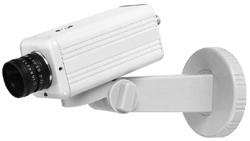
- Dummy cameras can be full bodied dummy CCTV Camera including lens and mounting bracket. They can use an actual camera body so it looks like the real thing.
- These should be destroyed and removed as they still induce paranoia and fear of punishment.
Hidden CCTV cameras
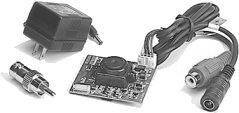
- They are useful for back-up surveillance in installations where the primary CCTV equipment is of a more traditional nature, i.e. standard cameras. In this case covert cameras can operate as a back-up where primary cameras are disabled by an intruder. Used mostly for temporary installations to catch repetitve criminal activity.
Wall mounted CCTV cameras
- Normally mounted just out of reach of an individual, but accessible by two people working together.
- Mostly protecting private property, but often also covering public space.
Roof mounted CCTV cameras
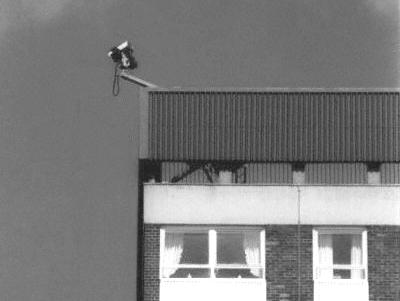
- Normally police traffic cameras, but sometimes private or large offices or institutions.
Street post mounted CCTV cameras
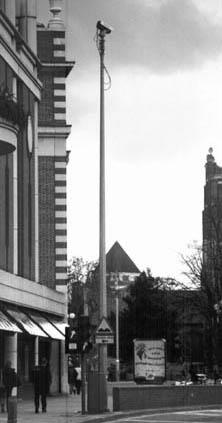
- Normally local authority operated for surveillance of shopping areas or police traffic cameras.
Methods of attack
Plastic bag
- Plastic bag filled with glue does the trick nicely.
- Cheap and almost as effective as other short term techniques. Use industrial grade bags which are thicker. Sometimes a camera going into repair will be “bagged” over, so visually it's ambiguous. To bag a camera there's a high chance that you can reach it with ease. If this is the case don't hesitate to smash the glass, lens and any other components. Don't bag it afterwards, people need to see the units smashed.
- Gives clear indication of inoperability.
Sticker and tape
- Placing of sticker or tape over lens.
- Good training activity.
- Gives clear indication of inoperability.
Paint gun

- Use a child's power water pistol with household paint.
- Fast, fun and easy method. Highly recommended.
- Easy to disable many cameras in a short period of time. a typical one hour action can easily take out 10 cameras.
- Carry reserve paint in plastic containers.
- Filter paint to remove lumps to avoid blocking gun.
- Go for lens first and then cover the rest of the camera and surrounding area.
- Clear indication of inoperability, plus draws further attention to the camera.
- Camera is easily cleaned so only effective for short time only.
- We used a “Super Soaker SC 400: 2000 Edition” camouflaged for urban night actions.
- With a 50/50 mix of water based house paint (emulsion) and water we could hit targets easily at 4.5m above the ground.
- Such a paint mixture totally obscures view through glass lens cover once applied.
- Be prepared to get splattered: use disposable clothing.
- No climbing required.
Laser pointer

- Fairly powerful laser pointers can be purchased for low cost.
- Laser pointers of 5 mW or more can temporarily blind and may even permantently damage CCTV cameras.
- For guaranteed destruction a more powerful laser would be required.
- But hazard of damaging eyes from misdirected pointing or reflection from the camera lense cover.
- Also, very difficult to keep laser beam precisely still from any reasonable distance.
- Can be attached to binoculars for better aiming.
- No indication of inoperability of camera.
- Would not recomend this method.
Cable cutting
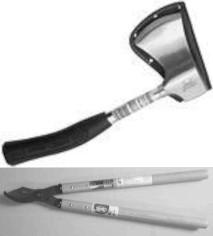
- Cables can be cut with either a sharp hand axe or garden pruning tools.
- Make sure tools are electrically insulated to prevent shock from camera power supply.
- Casual glance at dangling cables will reveal that camera is inoperable.
- Requires complete costly rewiring.
- Satisfying sparks emitted when cables cut.
Block drop
- Climb to the roof of the building on which the camera is mounted with some heavy weights (e.g. concrete blocks) and drop them on the cameras below.
- Get correct drop position by dropping small stones first.
- Camera will be totally destroyed in a shower of sparks.
- Scaling tall buidlings with concrete blocks requires a certain level of fitness.
- Pay careful attention to safety of others below.
- This is a seriously hardcore method.
Training
Training is essential for not only fitness, but also for developing techniques and more importantly preparing for unpredictable events.
Working together
- Get to know your partner very well.
- You will need to know your partners limits and abilities.
- You will need to know how much you can trust each other.
Fitness
- You can never be too fit.
- Vary your exercises, but best training is actually doing.
- Dont go to the gym — you need to be deconditioned not conditioned.
- Play on the terrain you will operate on.
- Start on something easy like stickering.
Learning the territory
- Know every part of the area you will operate in.
- Explore by day and night.
- Climb every tree, building.
- Explore every alley, bush and tunnel.
- Climb every wall and railing and fence.
- Don't use paths or streets (only cross them at right angles).
- If you have a police helicopter in your area then train aerial counter-surveillance (i.e. scout existing cover, prepare flares, smoke bombs).

 Español
Español